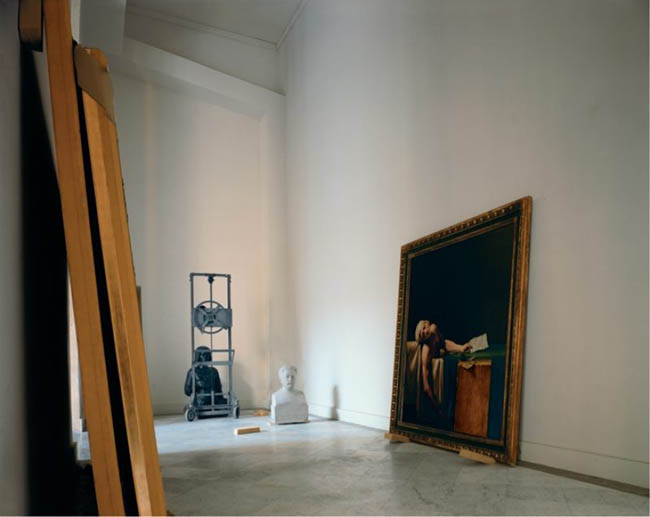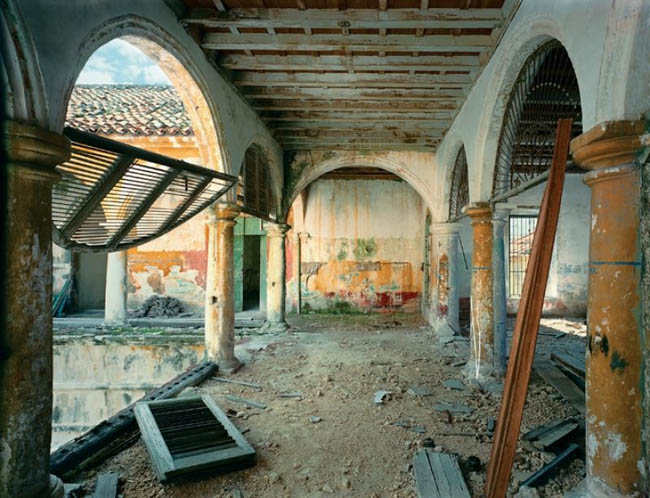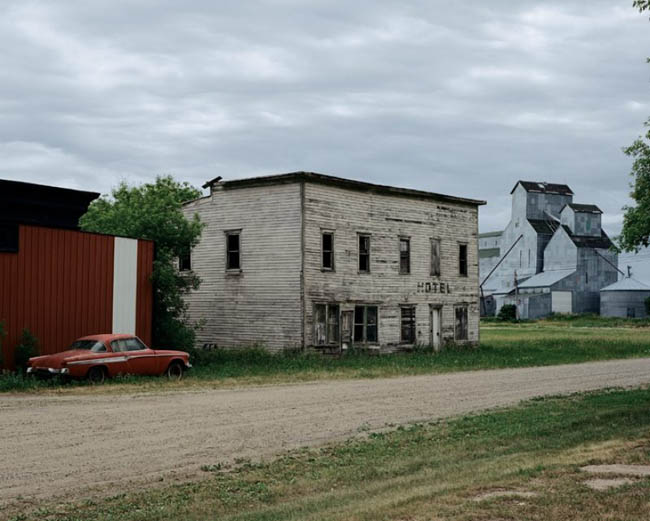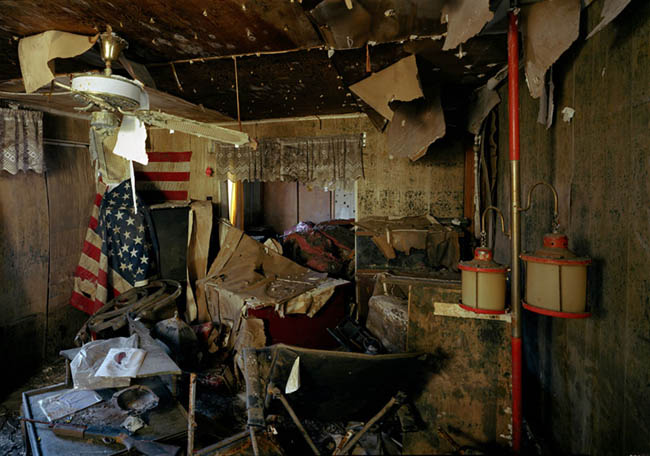Traditional architectural photography is documentary. It’s intended to be aesthetically pleasing, of course, but the primary concern is to accurately depict the appearance of a structure. Most architectural photographers come to their craft through their love of architecture. Robert Polidori is different; he’s different in his approach and different in his motivation. He’s different in about as many ways as it’s possible to be different.
First, Polidori isn’t an architect. Second, he’s not particularly interested in architecture itself…not in terms of design, usage or theory. His photographs are generally considered more interpretive than documentary, yet it’s impossible to dismiss the documentary importance of his work. He’s not particularly interested in buildings; he’s interested in rooms. Strangest of all, Polidori came to architectural photography through a passion for avant-garde film and a curiosity about historical mnemonic devices.

While an art student at SUNY Buffalo Polidori took a job at the Anthology Film Archives. That sparked his interest in cinema. Around the same time, he encountered a book by Frances Yates, The Art of Memory, which is about ancient memory enhancement systems. I’ll spare you a discussion on the use of the significance of the “memory palace” in renaissance scholarship (although I’d recommend The Memory Palace of Matteo Ricci by Jonathan Spence as both a good introduction to the practice and a wonderful history of a Western scholar’s travels in China). The important thing is that Polidori became fascinated by the notion of rooms as a metaphor.
Polidori had an intriguing opportunity through which he could explore the concept of the room as a metaphor. He had a friend who managed an apartment building in New York. When a tenant would die, that friend would allow Polidori to enter the apartment and film the rooms. The idea was to show how rooms have layers of meaning and significance, personal strata that reveal something about the people who inhabit those rooms.
In filming those rooms, Polidori discovered something important: “Practically speaking, rooms simply don’t look that good in film.” He didn’t find a moving image of a static space very aesthetically pleasing. He earned his Master’s degree in Art but eventually abandoned film as a medium. Cinematography, he decided, was appropriate for things that moved; for things that were still, still images were more suitable. His interest in the metaphorical properties of rooms, however, continued unabated. Not surprisingly, he decided to take up still photography.

Polidori didn’t much care for the modern photography of the time–the late 1970s. He had no interest in Cartier-Bresson and his ‘decisive moment.’ He found such images to be myopic and fragmentary. The photographs he liked, he realized, had all been long exposures taken by large format cameras. He was also intrigued by a comment made by German photographer Dieter Appelt, who said “…the snapshot is of a moment that will never occur again, and the long exposure is of a moment that never occurred to begin with.” Polidori bought himself a large format camera.
In the early 1980s Polidori was living in France. During a visit with a friend who lived in Versailles, he was encouraged to go see the famous chateau. Polidori became fascinated by the scope of the palace itself, which contains more than 700 rooms. Although the chateau was undergoing reconstruction at the time, he managed to obtain permission to photograph it. Those photographs were published in a book and exhibited both in France and the U.S. Although the photographs were meant to explore his notion of rooms as metaphor, Polidori’s publisher told him “Nobody’s going to buy that. We’re making for you the best coffee table book that’s ever been made on the subject.” No unknown photographer or writer carries any weight with a publisher, of course. The publisher wanted an architectural coffee table book, and that’s what he go. So began Polidori’s career as an architectural photographer.
From a struggling conceptual artist, Polidori quickly became a successful architectural photographer. His work appeared in Vanity Fair and Fortune magazines. He was hired as a staff photographer by The New Yorker. Although his personal interest remained focused on the psychological architecture of interior rooms, he found himself shooting a lot of exterior images. He was sent on assignment all over the world. He photographed the war-torn city of Beirut, in Chernobyl and Pripyat he photographed the homes and public buildings abandoned after the meltdown of the nuclear plant, in Brasilia he photographed the city’s 1950s modernist designs. He photographed Havana and New York City and North Dakota.

His work was much celebrated and he exhibited in galleries on at least two continents. He was popular and making an excellent living and there wasn’t a breath of controversy in his work. Then at the end of August, 2005 Hurricane Katrina ravaged the Gulf Coast of the U.S. and destroyed the city of New Orleans, where Polidori had spent part of his youth.
In September, just three weeks after the hurricane struck, Polidori went to New Orleans on assignment for The New Yorker. Accompanied by volunteers from the police and military rescue and recovery teams, he began to photograph the destruction. Not just the exteriors, but the interiors of the abandoned houses. In a way, his work had returned to original interest: rooms.
These were rooms unlike anything he’d ever seen. Even in the towns abandoned after the disaster at Chernobyl, the people who were evacuated returned long enough to reclaim many of their personal possessions…family photos, dolls, heirloom furniture. Later, of course, they had to destroy those items when they realized they were contaminated with radioactive material, but the homes had been largely stripped of the layers of personal history that intrigued Polidori. In New Orleans, however, those possessions were mostly still there. The victims of the hurricane and the flooding hadn’t time to remove them before fleeing, and hadn’t been allowed yet to return to collect them. Even in subsequent trips, those personal items remained behind simply because they had rotted away, or were saturated with foul-smelling muck, or were so damaged by water and mud as to have lost even their sentimental value.
After his initial trip to New Orleans for The New Yorker, Polidori returned three more times at his own expense, continuing to photograph the damage. The conditions were extremely difficult for large format photography, but he persisted. In one house they discovered a dead body wrapped in a blanket, covered with flies. Polidori included the covered body in his photograph.

When the first photographs appeared, the non-controversial architectural photographer found himself at the center of contentious debate. He was criticized for including the body (although it was visible only as a blanket-covered shape), he was accused of ignoring the victims and focusing only on the buildings (although almost none of the city’s inhabitants had returned at that time), he was castigated for making money off the suffering of others (despite the fact that he spent approximately US$100,000 of his own money to finance the trips and prepare the photos for publication), and he was accused of treating the disaster as an opportunity to create art.
The publication of his book on the aftermath of Katrina has earned him, according to his statement, about $30,000. It is an admittedly odd book; 336 pages containing more than 500 10×14 inch prints, it weighs almost ten pounds and costs $90. There was almost no market for the book; the victims of Katrina can’t afford it (even if they wanted it) and although the images have a strange sort of decayed beauty, it doesn’t appeal to collectors of fine art photography. The book appears to be more of a testament than a commercial enterprise. It is an artistic rendering of an event and a witnessing of lives that no longer exist. Not just the lives of those who died, but the lives of those who have lost their personal histories. These rooms once had meaning, and now that meaning exists only in memory and in Polidori’s images.
When his Katrina photographs (printed at 3×5 feet) were exhibited at the Metropolitan Museum in New York, it became the most-attended photography show in the history of the museum. Natives of New Orleans openly wept.
“I don’t take photographs because I love doing it, though I don’t hate it. Some photographers are in love with the process of taking a picture. Psychologically, I’m more interested in the situations that taking the picture puts me through, and what it forces me to witness…. It’s like I’m collecting evidence, like a detective looking to solve a case. I don’t mean that literally, but I use it as a simile. It’s a thing about phenomena and asking questions. And answering some, but not answering all of them.”
Questions inhabit almost all of Polidori’s work. Who lived here? Who worked here? What were their lives like? How did their lives shape this structure, these rooms? In the end, his work isn’t about architecture at all. It’s about the various ways people occupy their environment, it’s about the ways individual values and ideas manifest themselves in the places they live and work. Polidori isn’t really photographing buildings; he’s still photographing metaphors.
